Francis Henry Somerset
2nd Lieutenant Francis Henry (Frank) Somerset, D Company, 3rd South African Infantry Regiment
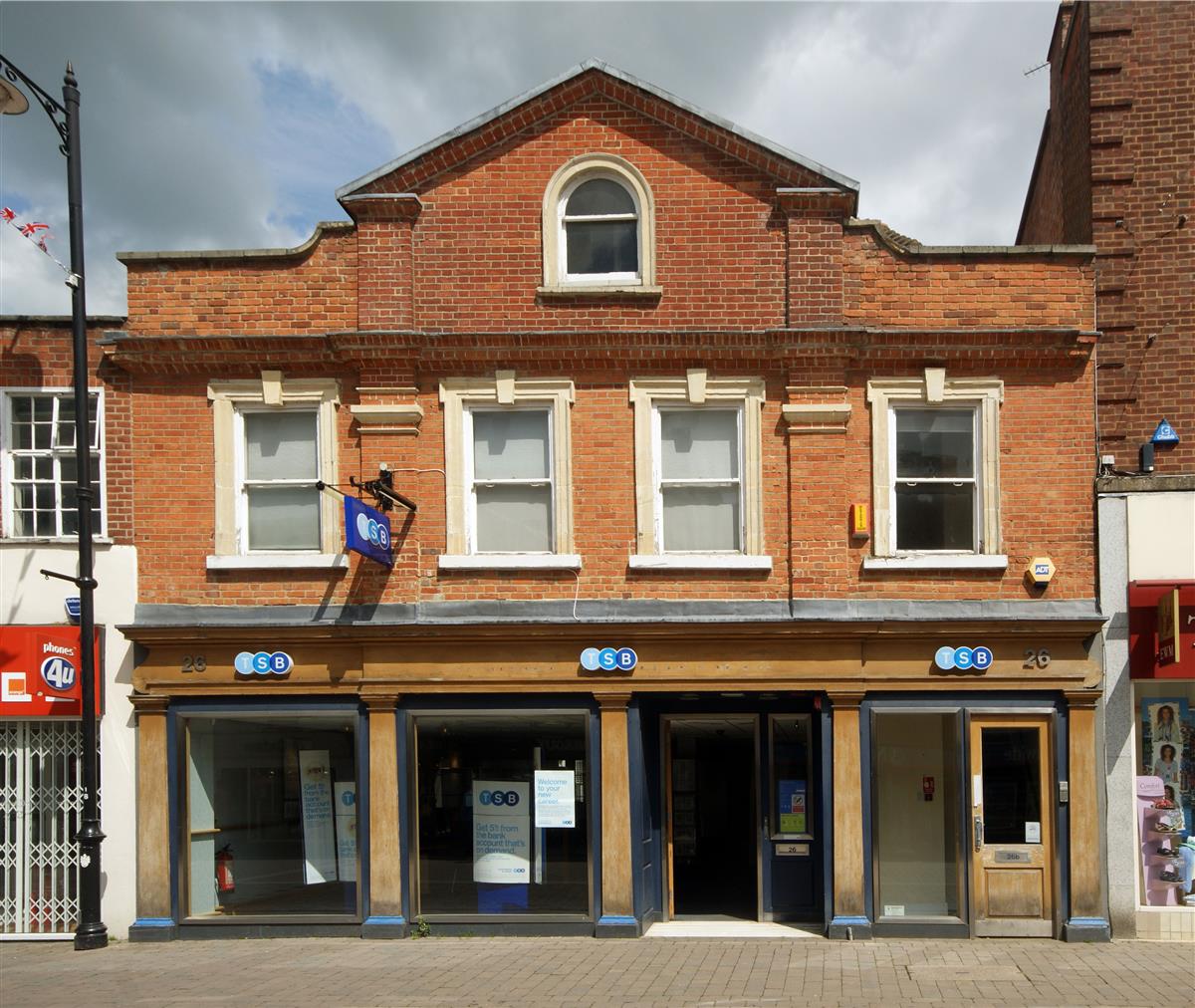
The Somerset family house in 2015, in use as a branch of the TSB. |
Frank (as he was known) was born on 5 September 1882, the eldest child of Henry Somerset and his wife Mary Bown née Peren. His seven siblings were Edmund Edgerley (born 1883), Edward Owen (1885), Arthur (1886), Lionel (1888), Burchall (1889), Mary Irene (1890) and Edith Isobel (1893). Arthur’s life was tragically short and he died very soon after his birth.
Henry Somerset was a son of Francis Flower Somerset and Jane Rowell; his mother’s family was intricately connected with the Northbrook Street brewery, sometimes known as the Castle Brewery but best remembered as the Newbury Brewery Co. This limited company was created by Henry’s father after he became the sole proprietor of the brewery when his wife’s uncle, John Satchell, sold him his share of the company - ending a succession of partnerships involving the descendents (Comptons, Rowells and Satchells) of a local entrepreneur, Thomas Smith (builder of Smith’s Crescent in Shaw Road).
Henry became manager of the brewery and lived with his family in the brewery house (26 & 27 Northbrook Street), recently the Cheltenham & Gloucester and now TSB. Young Frank was educated at Newbury Grammar School.
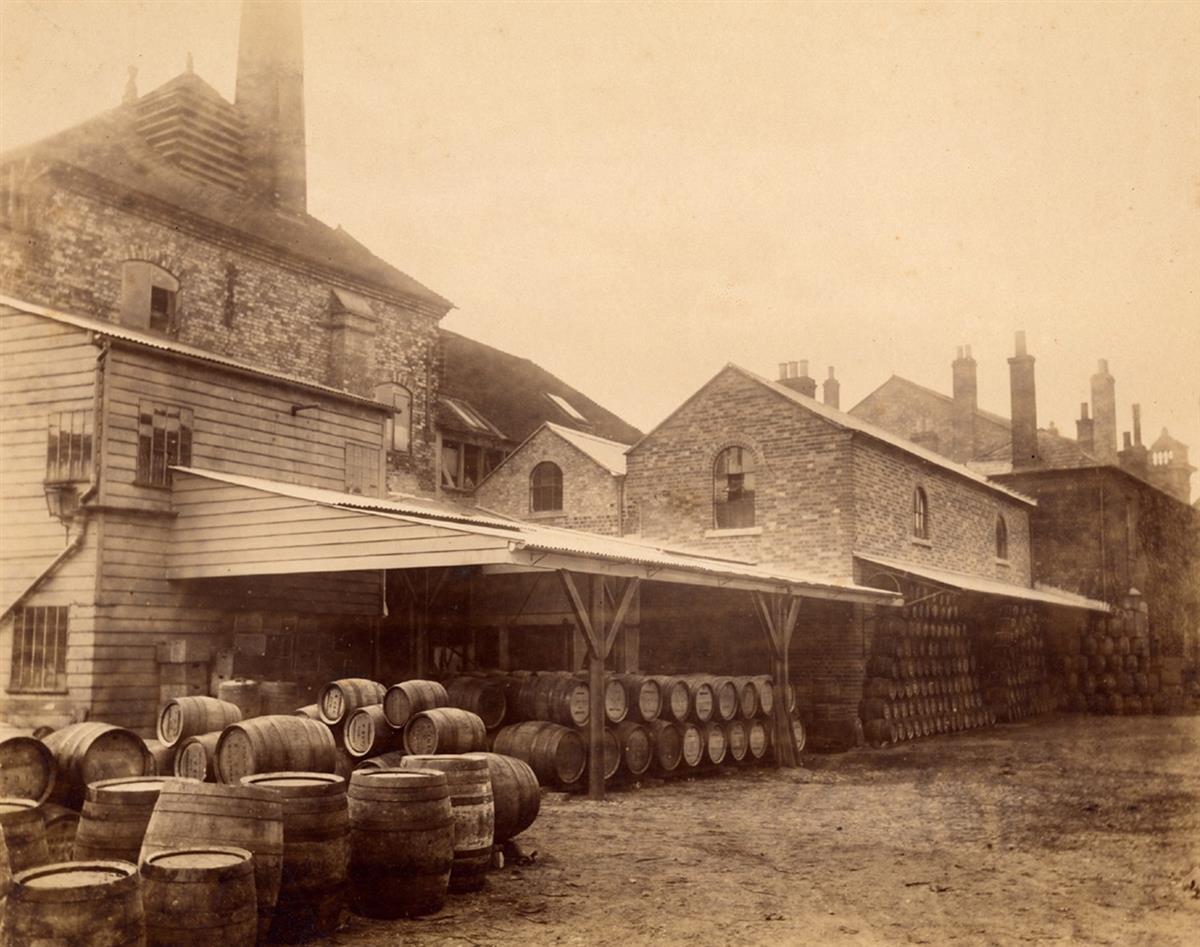
A part of the brewery premises behind the house in Northbrook Street, giving some idea of the scale of the business. |
Henry’s widow, Mary, and her brother Robert Henry Peren were executors of Henry’s will in which he left over £5,000 in ‘effects’ – a very sizeable sum in 1897. Robert was a manager in the insurance business – which may well have influenced his nephews’ choice of career; none of them entered the family business in Newbury, instead they became clerks in banking and insurance, the first step towards a career in finance.
Frank and Edmund left England for South Africa while they were still teenagers, probably to a relative or business contact of their uncle. While they were there the Second Boer War broke out and, being young and patriotic on 25 February 1901 both boys signed up for a local unit known as French’s Scouts. This was one of a number of mounted units recruited from local men to support regular British troops and to campaign and fight more like the Boers.
Their enlistment papers give an insight into the boys’ physical appearance: Frank was 5ft 6ins tall and weighed 9st 6lb, he had a fair complexion, brown eyes and red hair; Edmund was taller, 5ft 7ins but thinner, 9st 3lb, also with a fair complexion but with light brown eyes and fair hair. Frank gave his profession as bank clerk, Edmund as insurance clerk.
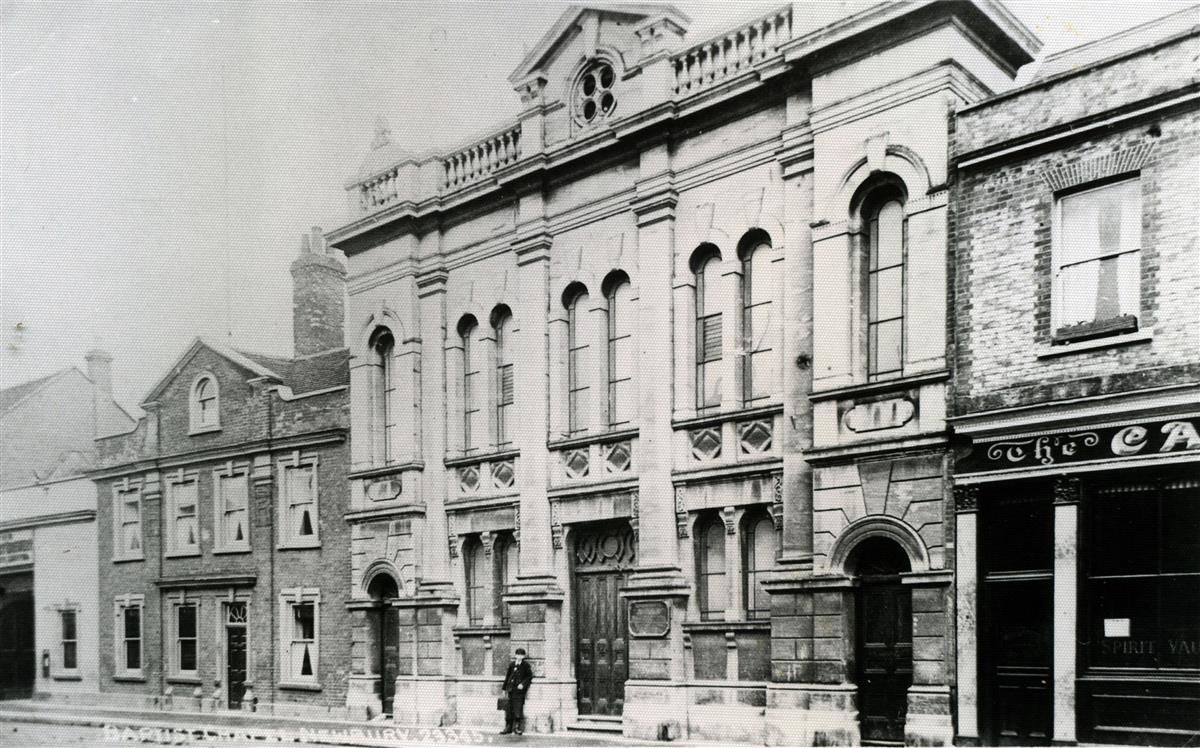 Northbrook Street Baptist Church - this would have been a familar scene to Frank when the family lived in the brewery house next door. Northbrook Street Baptist Church - this would have been a familar scene to Frank when the family lived in the brewery house next door. |
French’s Scouts were named after Major General John French a popular cavalry commander who had just ended the siege of Mafeking when the Somerset brothers enlisted. French, would become the commander of the British Expeditionary Force sent to France in 1914 losing his job to Douglas Haig after the Battle of Loos in the autumn 1915. The Scouts named after him were a very different form of mounted unit than the cavalry John French was accustomed to. These were irregular troops used mainly for reconnaissance work; they were directly comparable to the Boer guerrillas who where giving the British Army such a hard time. As such one imagines a typical recruit being a rancher’s son, accustomed to spending a lot of his life in the saddle, familiar with the rifle he carried to hunt and defend himself against the more dangerous of the local wildlife. How a pair of teenage office clerks came to join a unit such as this is a mystery.
Enlistment in the Scouts was for a minimum period of six months, extendable with the recruit’s agreement. In August 1901 the unit suffered its greatest setback of the war when a detachment of 50 men was surrounded and forced to surrender near Bethseda in the Cape Colony (now Eastern Cape Province). Perhaps it was this event that caused Edmund to decide not to extend his service beyond six months? Whatever the reason he was discharged ‘time expired’ on 28 August 1901.
Frank remained with the Scouts for another three months, until temporary unfitness forced his discharge on 25 November 1901. The problem was with his back and joints, which were causing him significant pain; he first complained of the problem in July blaming the problem on sleeping rough on the cold winter nights.
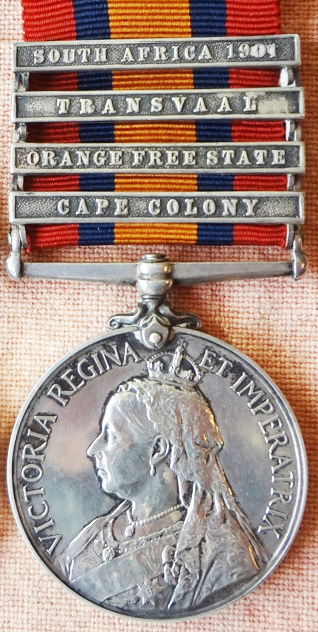
Queen's South Africa Medal with the same clasps as were awarded to Frank and Edmund. |
The war appears to have cured Frank of any desire to be a bank clerk and he spent a period in the South African police and also took and passed with honours the entrance exam for the Woods and Forests Department.
Elsewhere his brother Lionel emigrated to Canada in 1905, followed by Burchall in 1906 and their mother and sister Edith in 1912.
When Britain declared war on Germany in 1914 the government of the Union of South Africa automatically became belligerents as part of the British Empire. This was not universally popular among the population, many of whom had fought against the British in the Boer Wars. Nevertheless Prime Minister Louis Botha, a former Boer leader himself, was strongly supportive of Britain, telling the government in London that South Africa could defend itself and that all British troops stationed in the colony could be released for duty elsewhere; he also committed South Africa to an invasion of German South West Africa (now Namibia).
Botha was true to his word, but, before he could send troops to invade the neighbouring German colony he had to suppress a rebellion, known as the Maritz Rebellion, by hardline Boers who felt that the time was right to declare independence from Britain and set up an independent Boer state. The leaders of the rebellion were encouraged by the Germans to see the British as fatally weakened by their commitment to the war in France.
Frank was back in action during the short campaign that crushed the rebellion in October/November 1914. The surrender of the last active rebel leader took place in February 1915.
In September 1914 British troops made an abortive attempt to invade German South West Africa; it was not until February that Botha was ready to fulfil his promise to the London government to invade the German colony. However, it was worth the wait, South African troops (including Frank) soon overcame the German forces, the final contingent surrendering at Khorab on 20 July 1915.
Frank then became a member of the 1st South African Brigade which was sent to England where it landed in November 1915. Initially destined for France a late change of plan saw the South African Brigade sent to Egypt where it faced the Senussi rebellion as a part of the Western Frontier Force. The Senussi, a religious sect in Libya and Egypt had been persuaded by the Ottomans to declare jihad and rise against their Italian and British colonial overlords. By the time the South African Brigade arrived the danger to Egypt had all but passed and, by the end of March 1916, it was decided that the South Africans would be of more use elsewhere. In the middle of April the brigade sailed from Alexandria to Marseilles; by 23 April they were at Steenwerck, west of Ieper (Ypres) on the Franco-Belgian border. This move also saw Frank promoted to a commission as a Second-Lieutenant in the 3rd Battalion (or Regiment) South African Infantry, one of four such battalions in the brigade.
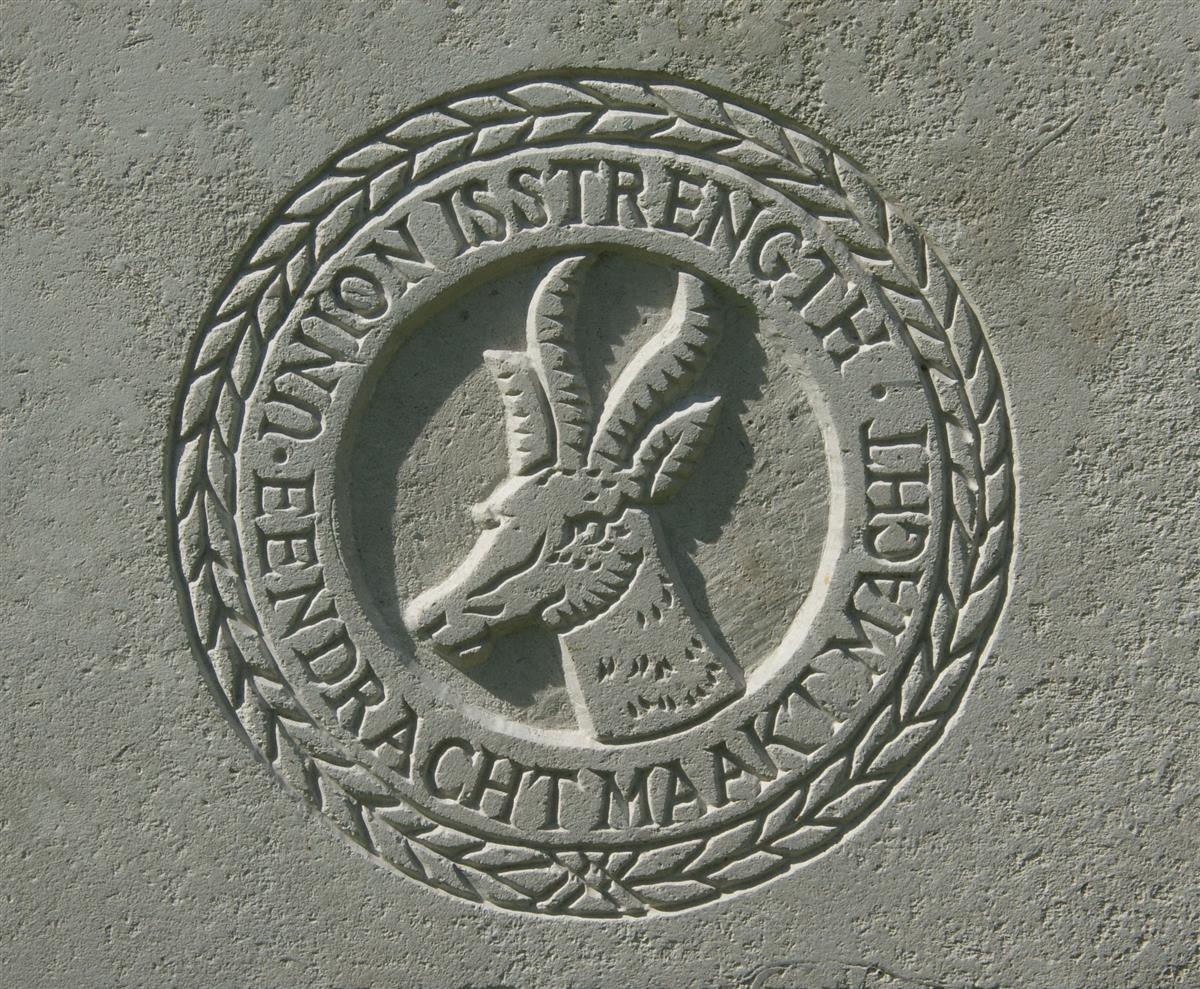
The South African Infantry cap badge, as used on CWGC headstones. |
A number of those missing had been captured by the enemy; one of these, Captain Richard Medlicott, commanding B Company, 3rd Battalion, smuggled a letter out of the POW camp in Gutersloh where he was being held. The letter included a report on his activities in the wood which he asked to be copied to his commanding officer, Lt Col Thackeray. One passage relating to 18 July is very pertinent:
The bombardment was intense all day our fellows and a platoon of the 4th Regiment dug themselves in. Suffering from want of food and water; and the wounded impossible to get away D Coy retired without passing up any word, so did those on their left. MY ORDERS WERE TO HOLD ON. I was on point of salient and furthest force pushed out.
A and C Coys on my right not being dug in were scattered - 1 platoon D Coy under Somerset did well on my left. I used 4th Regt in reserve trench as reinforcements. Ammunition scarce. Mud caused ammunition to be useless - also wounded mens' rifles jammed with mud. No cleaning material - all consumed. Two guns, one Lewis and one Maxim knocked out. Our own field guns killed and wounded many of us. Difficulty owing to this to extend to my left . . D Coy retired when the attack came at probably 5pm or later; however beat Germans off. Many killed seven yards from my trenches. Remnants of A and C Coys overpowered . . . I learnt this after heat of attack abated, with machine-guns enfilading us from my right. By passing up five rounds at a time from each man I kept machine-guns and one Lewis gun going sparingly Killed many Germans. I divided my front i.e. alternate men facing alternate fronts. Sent bombing party and patrol under officer to try and clear my right and get away to retire to Waterloo [i.e. Waterlot Farm] or our old regimental headquarters.
For a fuller account of the action in Delville Wood click here.
This account praising Frank shows he was still active on 18 July, contradicting the initial report of his death which was received by his family in Newbury in October (as they were not next-of-kin it is very likely that the news travelled first to South Africa, then to his mother in Canada before reaching Newbury. It was reported in the local paper:
Newbury Weekly News, 19 October 1916 – Local War Notes
Newbury people will hear with great regret of the death of Second Lieutenant Francis Henry Somerset, South African Infantry, eldest son of the late Captain Henry Somerset, of Newbury, and of Mrs Henry Somerset, now in British Colombia. Although only 34 years of age, he had seen much military service. He fought in the South African War and also in the Maritz Rebellion. He was for some time in the South African Constabulary, and passed with honours for the Woods and Forests Department, being offered a travelling scholarship, which he did not take. When the present war broke out, he joined the Imperial Light Horse, and served through the German South-West Campaign, at the end of which he came to England with the South African Infantry. He was sent to Egypt, fought against the Senussi, and was then given his commission and sent elsewhere. He was killed about July 17. Mrs Somerset’s youngest son, Burchall, of the Canadian Mounted Rifles, was killed last May. The late Captain Henry Somerset was associated with the old-established Newbury Company, and for many years was the popular commandant of the E (Newbury) Company of the Royal Berks Rifle Volunteers.
Officially Frank’s date of death is now 20 July, the day the brigade was relieved – as a junior officer his chances of survival were always slim.
Frank was buried in grave VI.I.2 at Delville Wood Cemetery, Longueval, a matter of yards from where he perished. However, this was the result of the post war clean up of the battlefields and the concentration of burials into the cemeteries that can be seen today. Frank’s remains were originally buried in another location and marked with a cross, enabling them to be identified. Sadly the information regarding the location of his first grave is a little vague; the map reference given covers about 200 acres of Delville Wood.
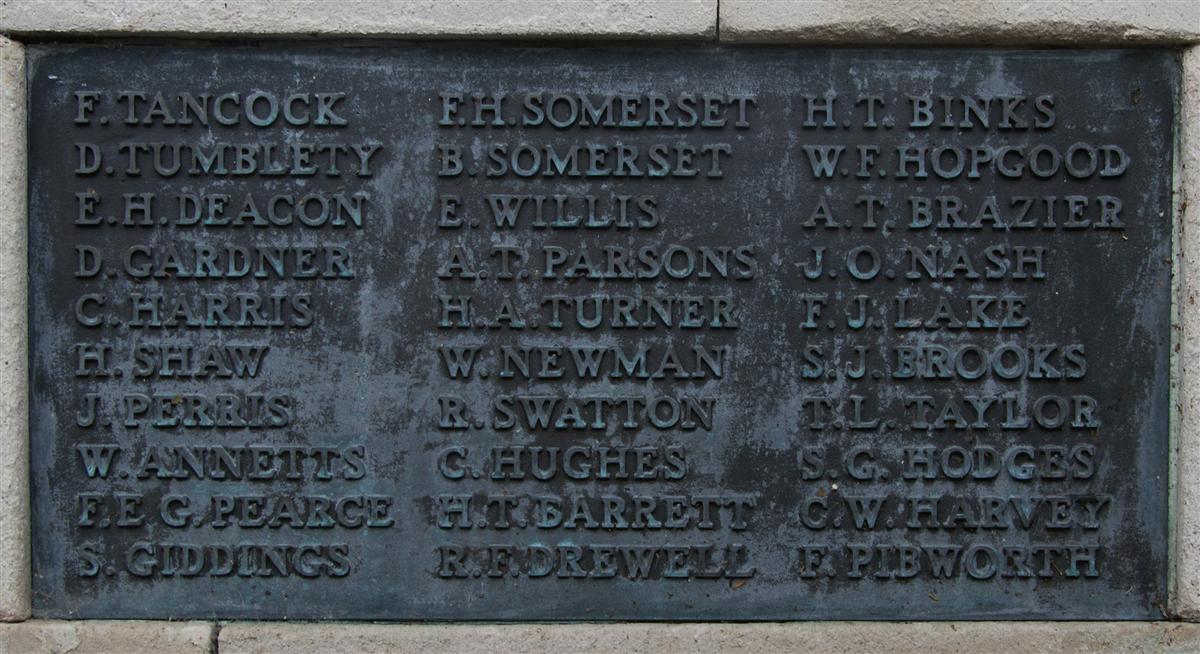
Frank's name on Newbury War Memorial, immediately above that of his brother Burchall. (top centre) |
Family
As has been noted above Edmund Edgerley Somerset (born 29 October 1883) also emigrated to Africa and fought alongside Frank in French’s Scouts for a few months during the Second Boer War. It is not known if he served during WW1, South African records are only available by visiting the archives in Pretoria, the cost of which has proved prohibitive to date. After the war he is known to have been living at Que Que in Southern Rhodesia (now Zimbabwe), where he was employed at the local lime works. His mother joined him in the 1920s. He died in Salisbury (now Harare) on 23 April 1930 (St George’s Day) leaving a widow, Violet Malvina.
Edward Owen Somerset is a bit of a mystery; no trace has been found of him after the 1901 census, when he was living with his mother in London. In the 1911 census his mother filled in columns asking for the total number of children resulting from her marriage, the number still living and the number who died. She recorded that two had died; Arthur is known to have died very soon after his birth, and the remaining six children can be found in post-1911 records, so it is logical to assume that the second death was that of Edward – however, if this is the case his death went unrecorded in England. Perhaps he followed his brothers to South Africa and died there?
Lionel and Burchall’s stories are told here.
Mary Irene and Edith Isobel were both educated at St Michael’s Orphanage in Croydon (see Burchall) where they were resident in 1901. The 1911 census records their mother living in a boarding house in Folkestone, Kent, while Irene is working as a governess with a family in the same town; the following year Edith accompanies her mother on a voyage to Canada, presumably to join up with Lionel and Burchall. No later record has been found relating to either sister, perhaps Irene also emigrated? English and Canadian records are generally available and their mother is known to have moved on from Canada to join Edmund in Rhodesia, perhaps the girls also ended up there, where records (eg of marriage or death) are not so accessible?
Bibliography & Websites
The History of the South African Forces in France, Buchan, John, Thomas Nelson & Sons, 1920.
Anglo Boer War Forum
Delville Wood, Gethsemane for the South African Brigade, I S Uys

Find a memorial :
| Died this day: | |
| 15 January 1943 | |
| L C Lawrence | |
| Newbury |

Like this site? Show your appreciation through a donation to a great charity.